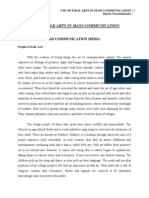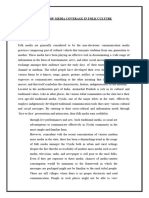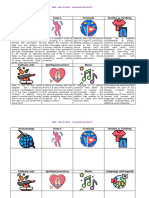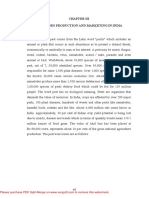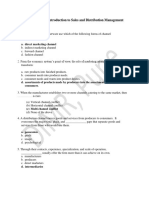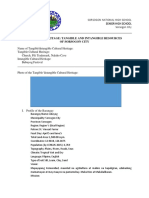Heritage and Creative Enterprise: Ananya Bhattacharya
Heritage and Creative Enterprise: Ananya Bhattacharya
Uploaded by
dineshjain11Copyright:
Available Formats
Heritage and Creative Enterprise: Ananya Bhattacharya
Heritage and Creative Enterprise: Ananya Bhattacharya
Uploaded by
dineshjain11Original Description:
Original Title
Copyright
Available Formats
Share this document
Did you find this document useful?
Is this content inappropriate?
Copyright:
Available Formats
Heritage and Creative Enterprise: Ananya Bhattacharya
Heritage and Creative Enterprise: Ananya Bhattacharya
Uploaded by
dineshjain11Copyright:
Available Formats
Heritage and Creative Enterprise
Ananya Bhattacharya
Heritage and Creative Enterprise
Heritage and Creative Enterprise
Ananya Bhattacharya
Social Entrepreneur, Calcutta
Culture as livelihood
Culture is the expression of a society's aesthetic,
moral and spiritual values. It transmits the heritage of
the past and creates the heritage of the future. Although
cultures themselves are dynamic, vibrant and evolving,
they are fragile in the face of political, social and
economic changes. Oral traditions and performing arts,
which live on in the memory and daily life of rural and
indigenous people are being obliterated by changes in
lifestyle due to factors like industrialisation, globalisation,
urbanisation and so on.
Loss of intangible heritage may lead to loss of identity
for the people and to the breakdown of cultural systems.
Safeguarding intangible heritage is thus an imperative in
todays world. Developing creative enterprises based on
cultural heritage again raises issues like authenticity and
commodification. This may be addressed by making the
artist community a key stakeholder in the process. This
article describes a successful approach to developing
community-led creative enterprises based on intangible
heritage, which has beenconceived, evolved and managed
by banglanatak dot com (www.banglanatak.com).
Banglanatak dot com, a social enterprise in India, has
a mission to relieve poverty by using culture-based
approaches. The organisations vision is to synergise
cultural and economic development leading not only to
the preservation of cultural heritage and diversity, but
also to facilitating the sustainable development of people.
The flagship initiative of the organisation Making Art a
Livelihood, initiated in 2004, aims at utilising the
potential of a communitys intangible heritage (ICH) skills like performing arts and crafts - for creating
opportunities for sustainable livelihoods.
Generating opportunities for adequate employment
and income remains an unmet critical need, especially
for poor and deprived people who lack formal education
and the skills for conventional job markets. The following
paragraphs describe how creative enterprises based on
a communitys cultural capital offer promising ways for
safeguarding heritage and also for using a communitys
cultural capital as a financial asset.
Art forms of Bengal
The soil of Bengal is replete with cultural traditions
which find their roots in its diverse communities, in their
art forms as well as in different religious practices.
100
Banglanatak has worked with 3,200 folk artists
performing six forms of Bengali folk art. Two of these are
Chau and Jhumur - dance and song traditions of
indigenous communities of the Chotonagpur plateau
area. Purulia Chau is a vigorous form of martial dance
and drama. Dazzling costumes, rhythmic drumming,
powerful acrobatic movements and somersaults in the
air make the dance a marvel to watch. Jhumur songs
and dances are integral to the social practices and rituals
of agrarian and artisan communities as well as those of
forest dwellers. Jhumur songs are soulful manifestations
of everyday struggles and tribulations. These common
threads - human emotions like happiness, sorrow, love
and loss - are woven soulfully into each performance
which makes this folk form widely accepted among all
sections of the society.
The third art form is Patachitra, the scroll paintings
produced in the Medinipur region of Bengal. The painters
called Patuas or Chitrakars (meaning artists), are a
unique group of folk artists who are painters, lyricists,
performers and singers all in one. They paint stories with
brilliant natural colours on long scrolls and sing about
them as they unfurl the scrolls.
Baul/Fakiri are mystical songs of Bengal which
preach about universal brotherhood and celebrate
humanity. Baul philosophy is influenced by Hindu Bhakti
movements and Sufism.
Domni and Gambhira are social satires popular in the
Malda region of Bengal. The performers use a wonderful
mix of song, dance and satire to communicate the woes,
concerns and worries of the common man.
A decade back, these art forms were languishing.
They were losing their traditional audience. The young
were not interested to learn them. Songs and dance
styles were being lost and a living heritage was dying.
Building enterprises
Today, these folk artists make a living from their art.
They are performers and painters and are engaged full
time in training, developing products, documentation and
performance. The artists have become entrepreneurs.
They run enterprises collectively, offering a wide array of
products and services based on their traditional heritage.
Involving the folk artist community in steering the
revitalisation and rejuvenation process was the
cornerstone of banglanataks strategy. Two hundred and
thirty-three self help groups were formed with 3,200 folk
artists. Capacity building, documentation, marketing and
promotional efforts revived and revitalised the six art
forms and created a new meaning for the artists
communities. They are now leading their own
development.
The artists are developing new ideas through
innovation and transformation in line with market
demands and trends. The Chau dancers who used to
perform mythological tales in traditional productions
running for three or four hours have now developed
productions which last for just twenty to forty minutes.
The folk singers select songs that relate to their
audience. They are creating new ways of rendering
traditional art forms and there is constant innovation and
creativity.
The culture we have showcased is not static it is the
living heritage of the people. The communities are artistic
in the modern sense. The Chau dancers are developing
productions based on the works of Shakespeare and
Tagore. The Patachitra painters are painting scrolls
depicting the Tsunami and 9/11. Domni and Gambhira
artists are using their drama to campaign for improved
rural sanitation and to stop child marriages. They have
become communication partners at the grass root level
for local government and NGOs. The folk instrument
players are jamming with jazz musicians. They have
developed folk orchestras which appeal to urban youth.
Active participation by the gurus who are the living
heritage has ensured the protection of aspects of
heritage and of the integrity of the cultural medium and
message. Constant exchange and exposure to diverse
cultural traditions has enabled innovations to be made.
The artists have performed in folk festivals across India
and even in China, the UK and Bangladesh, taking their
art into the global arena.
Local seats of learning and dissemination have been
developed. Six folk art centres, built on land donated by
the folk artists in six districts, have been equipped with
musical instruments and print, digital documentation
and communication facilities, and have become seats of
learning, promotion and dissemination for the arts.
People learn about the wealth of tribal folk culture and
Vol.06 2011 International Journal of Intangible Heritage 101
Heritage and Creative Enterprise
Figure 1
Baul singers performing during the Ananda Utsav in London.
http://banglanatak.com/
their respect for cultural diversity is strengthened.
The dying oral traditions have been documented and
recorded. Songs that were transmitted orally have been
published in books and disseminated among all the folk
artists. More than 1000 Baul, Fakiri, Jhumur and
Patachitra songs have been recorded. Audio and video
recordings have been published and promoted. Some of
the CDs pertain to specific genres, some showcase the
talent of a creative cluster residing in a particular village
giving that community a tool for self promotion. Films
have been made to document performances by the
carriers of living heritage, thus creating a repository of
dancing styles and songs for future reference. Extensive
media coverage has also helped in reaching out to
millions of people and gaining new audiences.
Heritage tourism
Community-led cultural tourism is being developed
to create incentives for safeguarding heritage. Thriving
cultural heritage, natural beauty and built heritage have
been integrated into the cultural heritage tourism trails.
The objective is to promote sustainable tourism as a
means of promoting socio-economic development and
also to bring about a system for the preservation of
heritage which otherwise will be lost to oblivion with the
onslaught of modernisation. Heritage tourism trails,
owned and managed by the folk artists, merge natural
beauty, temples and ruined palaces, vibrant folk
performances and fine local handicrafts to form one
collage which gives a distinctive identity to the places and
the people. The folk art heritage tourism trails offer
visitors a unique opportunity to enjoy folk tradition in its
myriad glories. Songs, dance, drama and traditional
craftsmanship are experienced in their local context.
Tourists get an opportunity to enjoy the rustic charm
of village life. The dwellings of indigenous people in
Purulia, for example, are colourfully decorated with hand
painted motifs. Tourists live a Baul experience in the
villages at Nadia, celebrating life and nature in a musical
environment. They are charmed by the host communitys
simplicity, hospitality, tranquillity and receptivity to other
cultures. The rhythmic tunes and the messages of love
and brotherhood always inspire.
The tourism trails promote community festivities and
rituals replete with grandeur and pomp as destinations
for tourists. Indigenous festivals reflect totemic beliefs,
nature worshipping, the celebration of hunting, sowing,
harvesting and of every aspect of human life. These
102
festivals highlight how performing arts are a way of life
for the people and not one-off commercial events for a
single audience. New festivals, like Vasanta Utsav at the
site of a 6th century temple at Cheliama, are building up
economic activity to serve tourists. Festivals for tourists
have provided new ways and events to revitalise social
functions which were being obliterated by the changing
times. Visitors at Pot Maya at village Naya marvel at the
colourful display of tapestry-telling stories ranging from
traditional epics to the devastation caused by the
Tsunami.
Owing to the constant creation of new products for
tourists there are no stereotypes and many people visit
the festivals repeatedly. The folk art centres facilitate
interaction between the local community and the visitors
whereby the tourists take back a piece of human history
and the local people share their rich heritage. Tourists
enjoy not only the final product but also the process production, training, composing, designing, mask making
and so on. There is complete absence of scripted
performance.
With a lot of visitors coming over to the villages to stay
and listen to or watch art at the folk art centres, the folk
artists feel proud of what they do and have even taken
initiatives in developing home stay based tourism.
Heritage tourism has evolved as a truly participative and
meaningful way of safeguarding intangible heritage
through the communities themselves.
Community empowerment
An enabling environment of social inclusion has been
fostered. Communities which were marginalised and
impoverished now have renewed pride and confidence.
They are transforming into grassroots social
entrepreneurs working to address their own communitys
problems using their cultural capital. They have become
agents for change in their communities.
The women who are earning money from their
performances and craftwork enjoy a new social status.
Their children are going to school. The artists and their
families (over 9,500 individuals) now have health
insurance. They also have sanitation and electricity at
home. They are using mobiles. The Chau artists now no
longer need to earn money in occupations that were
hazardous to their health - like binding tobacco leaves.
The average monthly income has increased from 10 to 20
USD per month to 60-70 USD with more than 20% of the
people earning between 150-250 USD. Young people have
Figure 2
Purulia Chau dance.
http://banglanatak.com/
Vol.06 2011 International Journal of Intangible Heritage 103
Heritage and Creative Enterprise
Figure 3
Tourists learning to paint Patachitra at the POT Maya festival in village of the Patuas.
http://banglanatak.com/
come forward to learn and practice their traditional arts
and crafts. They are travelling across continents to exhibit
their skills.
The process of skill transfer from one generation to
the next has been renewed though not necessarily
within the family. Besides economic empowerment, the
folk artists are now enjoying recognition by their
communities. They used to be daily labourers, hawkers
or farmers who used to sing and dance occasionally;
today they are recognised and respected as artists. All
these factors have made them the agents for change and
development in their own communities. They are now
more united and are overcoming the conflicts related to
caste divisions.
The development of creative enterprise with the local
community as a key stakeholder thus strengthens the
community economically, socially and culturally. Festivals
and tourism are developmental tools facilitating
interaction and exchange. Interaction between hosts and
the guests also fosters a spirit of universal brotherhood
and is a small step towards a conflict-free world.
104
You might also like
- Big BasketDocument3 pagesBig Basketdineshjain11100% (1)
- Promotion of Tourism Through Rich Folk Culture of West BengalDocument6 pagesPromotion of Tourism Through Rich Folk Culture of West Bengalwfshams100% (1)
- Destiny of Traditional Folk Arts in Conditions of Recent SocietyDocument7 pagesDestiny of Traditional Folk Arts in Conditions of Recent SocietyNgoc NguyenNo ratings yet
- Folk Music and LivelihoodDocument15 pagesFolk Music and Livelihoodswarupa rana100% (2)
- Reema Mondal3v27Document11 pagesReema Mondal3v27motivatedblinkNo ratings yet
- Andai DanceDocument23 pagesAndai DancekherlenNo ratings yet
- Karyala: Folk Theatre for Rural Communication in Himachal PradeshFrom EverandKaryala: Folk Theatre for Rural Communication in Himachal PradeshNo ratings yet
- Use of Folk Arts in CommunicationDocument21 pagesUse of Folk Arts in CommunicationRajesh Cheemalakonda100% (4)
- 4 T 3 MAGLALATIKDocument15 pages4 T 3 MAGLALATIKJohn Joseph Maynes67% (3)
- Intangible Cultural Heritage in BangladeshDocument4 pagesIntangible Cultural Heritage in Bangladeshদুর্জয় দুর্বারNo ratings yet
- Folk CultureDocument8 pagesFolk CultureArpita DasNo ratings yet
- Intangible Cultural Heritage of BangladeshDocument3 pagesIntangible Cultural Heritage of BangladeshTahfizul Hasan ZihanNo ratings yet
- Cultural ConservationDocument8 pagesCultural Conservation60 984No ratings yet
- Impact of Media Coverage in Folk CultureDocument59 pagesImpact of Media Coverage in Folk CultureMohit AggarwalNo ratings yet
- Bala PDFDocument4 pagesBala PDFArun BharatNo ratings yet
- Tribal Museum - An ExoticDocument4 pagesTribal Museum - An Exoticpushpen5115No ratings yet
- tribal artDocument6 pagestribal artkumaranil00000786No ratings yet
- Thesis Synopsis 2017Document7 pagesThesis Synopsis 2017Sanjana AppachuNo ratings yet
- Safeguarding Without FreezingDocument4 pagesSafeguarding Without FreezingaakritieNo ratings yet
- Filipino Cultural HeritageDocument14 pagesFilipino Cultural HeritageMia Grace Edaño Rosellosa100% (1)
- Contem 13 - 15Document7 pagesContem 13 - 15Yam IdrisNo ratings yet
- Preservation of Uzbek Traditional Music CultureDocument5 pagesPreservation of Uzbek Traditional Music CultureresearchparksNo ratings yet
- 12200-Article Text-14892-1-10-20191130Document10 pages12200-Article Text-14892-1-10-20191130soham chakrabortyNo ratings yet
- Contenido April Third GradeDocument7 pagesContenido April Third GradeRocio Vargas AvilaNo ratings yet
- Unit 2-1 (Folk Media)Document4 pagesUnit 2-1 (Folk Media)Jubayrul IslamNo ratings yet
- Traditional Folk MediaDocument31 pagesTraditional Folk Mediasohael67% (3)
- Folkloric Dances of EcuadorDocument4 pagesFolkloric Dances of EcuadorScribdTranslationsNo ratings yet
- 2.4 Folk MediaDocument8 pages2.4 Folk MediaKALYANI SHIMPINo ratings yet
- The Influence of Traditional Arts On Life of Kendal NgisorDocument2 pagesThe Influence of Traditional Arts On Life of Kendal NgisorAntonius WidiarsoNo ratings yet
- Week 2 062Document6 pagesWeek 2 062praneethyadav5432No ratings yet
- Iaf 2Document6 pagesIaf 2praneethyadav5432No ratings yet
- RRR Induction Presentation 01Document12 pagesRRR Induction Presentation 01Ivo BrecioNo ratings yet
- NotesDocument21 pagesNotesnashevangelista822No ratings yet
- Art and Design Folk Art and Warli Painting Design: Priyanka Cahudhary Roll No-27Document42 pagesArt and Design Folk Art and Warli Painting Design: Priyanka Cahudhary Roll No-27Sneha PeriwalNo ratings yet
- Culture Pages 3Document10 pagesCulture Pages 3Harshal MehrotraNo ratings yet
- Cultural Richness-Activities and Characteristics That Define A CultureDocument11 pagesCultural Richness-Activities and Characteristics That Define A CultureSSNo ratings yet
- Ethnopunk Manifesto - English VersionDocument2 pagesEthnopunk Manifesto - English VersionEthno PunkNo ratings yet
- Folk Culture-1700209580-437918690Folk CultureDocument17 pagesFolk Culture-1700209580-437918690Folk Culturedumpmail104No ratings yet
- CA 1, MANSI MA'AMDocument15 pagesCA 1, MANSI MA'AMbansalmanasvi1227No ratings yet
- Industrialisation of Asian Cultural Resources Case Study of IndiaDocument9 pagesIndustrialisation of Asian Cultural Resources Case Study of IndiaNayan ThumarNo ratings yet
- 1625560219Document44 pages1625560219Gaurav AggarwalNo ratings yet
- 1st ChapterDocument7 pages1st ChapterkrithicuttieNo ratings yet
- Eng Vera 一带一路视域下祭祀舞蹈的文化特征.zh-CN.enDocument13 pagesEng Vera 一带一路视域下祭祀舞蹈的文化特征.zh-CN.enCyntia IngridNo ratings yet
- Folk Media and TraditionalDocument20 pagesFolk Media and Traditionalzeeshanspeedster111No ratings yet
- March Gist of YojanaDocument8 pagesMarch Gist of YojanaNIKHIL KUMARNo ratings yet
- Konkani CultureDocument6 pagesKonkani CultureAyush SawantNo ratings yet
- Final AlaDocument2 pagesFinal AlaAnne SalardaNo ratings yet
- INATUDocument5 pagesINATUJanarose MalijaoNo ratings yet
- Reading The ImageDocument11 pagesReading The ImageRain Y.75% (4)
- Pcaeeabanillaungkay 240429072339 E3d5c9fcDocument20 pagesPcaeeabanillaungkay 240429072339 E3d5c9fcTuesday SacdalanNo ratings yet
- MooyDocument3 pagesMooyMiko Jane EstemberNo ratings yet
- Evolution of Music - Class Music 1Document6 pagesEvolution of Music - Class Music 1Heloisa Heng Su WanNo ratings yet
- Contemporary ArtsDocument18 pagesContemporary ArtsJimnet SosaNo ratings yet
- Avishiktaa Fybms101 CA 1Document17 pagesAvishiktaa Fybms101 CA 1bansalmanasvi1227No ratings yet
- Folklore of India 2Document3 pagesFolklore of India 221005011No ratings yet
- Cultural Heritage of NepalDocument9 pagesCultural Heritage of NepalSabin KaphleNo ratings yet
- Folk Theatre of India - Me22btech11011 - EssayDocument4 pagesFolk Theatre of India - Me22btech11011 - Essayme22btech11011No ratings yet
- Unveiling The Tapestry of Bengali CultureDocument2 pagesUnveiling The Tapestry of Bengali Culture2022pec5185No ratings yet
- June 2024Document16 pagesJune 2024akankshabhardwaj111No ratings yet
- Lesson Music Ad Arts Contemporary Performing Arts in Southeast Asia 1Document2 pagesLesson Music Ad Arts Contemporary Performing Arts in Southeast Asia 1baradiallanjamhyrNo ratings yet
- The International Journal of Humanities & Social StudiesDocument4 pagesThe International Journal of Humanities & Social StudiesAshu PandeyNo ratings yet
- Chapter3 PDFDocument33 pagesChapter3 PDFdineshjain11No ratings yet
- DDocument299 pagesDdineshjain11No ratings yet
- Indian Banking System: Way Forward On The Current CrisisDocument1 pageIndian Banking System: Way Forward On The Current Crisisdineshjain11No ratings yet
- Math 331 Quiz - Hungarian Method: Time Per Job (Hours) Job 1 Job 2 Job 3 Job 4 Job 5Document1 pageMath 331 Quiz - Hungarian Method: Time Per Job (Hours) Job 1 Job 2 Job 3 Job 4 Job 5dineshjain11No ratings yet
- CPBAE Brochure - IIM LucknowDocument8 pagesCPBAE Brochure - IIM Lucknownareshkumar.jnu6675No ratings yet
- Mundra PSLDocument7 pagesMundra PSLdineshjain11No ratings yet
- CictabDocument5 pagesCictabdineshjain11No ratings yet
- Winton Yerramilli JFE2008Document29 pagesWinton Yerramilli JFE2008dineshjain11No ratings yet
- SDMDocument6 pagesSDMMonika GuptaNo ratings yet
- Entrepreneurship Development: July 12-13, 2018 FORE Campus, New DelhiDocument5 pagesEntrepreneurship Development: July 12-13, 2018 FORE Campus, New Delhidineshjain11No ratings yet
- Sales & Distribution Project: Name: Subhanil Bhadra Sec: F1 FW2010-13Document32 pagesSales & Distribution Project: Name: Subhanil Bhadra Sec: F1 FW2010-13dineshjain11No ratings yet
- Survey of Consumer Awareness Towards Organic FoodDocument5 pagesSurvey of Consumer Awareness Towards Organic Fooddineshjain1150% (2)
- Greenbankworkshop For WebDocument100 pagesGreenbankworkshop For Webdineshjain11No ratings yet
- In What Context Are Terms Pledge, Hypothecation and Mortgage UsedDocument2 pagesIn What Context Are Terms Pledge, Hypothecation and Mortgage Useddineshjain11100% (3)
- Agriculture May 2017Document51 pagesAgriculture May 2017dineshjain11No ratings yet
- Recent Trends in Agricultural Credit in India: A Note R. RamakumarDocument11 pagesRecent Trends in Agricultural Credit in India: A Note R. Ramakumardineshjain11No ratings yet
- Cold StorageDocument22 pagesCold Storagedineshjain11100% (2)
- Percival Hall Lombard's Excavations at The Presumed Site of The Aptucxet Trading Post, Bourne, MassachusettsDocument37 pagesPercival Hall Lombard's Excavations at The Presumed Site of The Aptucxet Trading Post, Bourne, MassachusettsCraig ChartierNo ratings yet
- Ground Floor Plan: Maids Room +1'-6" W.C +1'-6"Document1 pageGround Floor Plan: Maids Room +1'-6" W.C +1'-6"G00705989No ratings yet
- Hoysala Green CL-7 PlanDocument1 pageHoysala Green CL-7 PlanGRACE TRINITYNo ratings yet
- 19331E0024 - Define Heritage and National HeritageDocument7 pages19331E0024 - Define Heritage and National HeritageDevadi SureshNo ratings yet
- California Cultural and Heritage Tourism Council "Working Together" SymposiumDocument51 pagesCalifornia Cultural and Heritage Tourism Council "Working Together" SymposiumAniela Maria BrasoveanuNo ratings yet
- International Cultural Tourism CharterDocument5 pagesInternational Cultural Tourism CharterMaggie SrniNo ratings yet
- The "Most Known" Lost City of The Incas or How To Preserve Choquequirao, Its "Authentic" Sacred SisterDocument10 pagesThe "Most Known" Lost City of The Incas or How To Preserve Choquequirao, Its "Authentic" Sacred SisterUnited States National Committee of the International Council on Monuments and SitesNo ratings yet
- Definition of Cultural HeritageDocument47 pagesDefinition of Cultural HeritageFlávia Mosqueira Possato Cardoso100% (1)
- Research 01: National Cultural Heritage Act of 2009Document16 pagesResearch 01: National Cultural Heritage Act of 2009Jayson IsipNo ratings yet
- Guillaume Blanc and Marie Bridonneau Making Heritage in EthiopiaDocument12 pagesGuillaume Blanc and Marie Bridonneau Making Heritage in EthiopiaDaniel AsmareNo ratings yet
- Boniface Muwadzi: Floor Area: 194 SQMDocument1 pageBoniface Muwadzi: Floor Area: 194 SQMTaurai ChiwanzaNo ratings yet
- Bài thuyết trình nhóm 3Document1 pageBài thuyết trình nhóm 3Nguyễn Quang HuyNo ratings yet
- Block-I: StructureDocument45 pagesBlock-I: StructureNataraj NataNo ratings yet
- Müzelerde Risk Yönetimi: Uluslararası Yaklaşımlar: Risk Management in Museums: International ApproachesDocument12 pagesMüzelerde Risk Yönetimi: Uluslararası Yaklaşımlar: Risk Management in Museums: International ApproachesLesia DoganNo ratings yet
- Comprehensive Zoning Ordinance of Davao City 2013 2022 2Document118 pagesComprehensive Zoning Ordinance of Davao City 2013 2022 2Vince Robert RamirezNo ratings yet
- F.floor PlanDocument1 pageF.floor PlanKamran SadiqNo ratings yet
- Abuyog StuffDocument7 pagesAbuyog StuffJolina MandoNo ratings yet
- Floor Plan 3RD DraftDocument1 pageFloor Plan 3RD DraftKevin CanillaNo ratings yet
- Guide For Cultural Landscape Design Proposal - Langkawi - Mar - Aug 2023Document13 pagesGuide For Cultural Landscape Design Proposal - Langkawi - Mar - Aug 2023NURUL AIN BINTI IBRAHIMNo ratings yet
- Tailoring 606 Iamdavad PDFDocument175 pagesTailoring 606 Iamdavad PDFTushar GorleNo ratings yet
- Sheet 1 Joinery Window Details 1Document1 pageSheet 1 Joinery Window Details 1Edwin johnNo ratings yet
- Essay 3 - Model Question Task: Riorities For Governments Aiming To Preserve Cultural HeritageDocument2 pagesEssay 3 - Model Question Task: Riorities For Governments Aiming To Preserve Cultural Heritagesernhaow_658673991No ratings yet
- Culture Makes Life Worth Living: Arts, Heritage and Cultural Plan 2017-2027Document52 pagesCulture Makes Life Worth Living: Arts, Heritage and Cultural Plan 2017-2027Dorje100% (1)
- The Sainte-Croix Collegiate Church: 1. PresentationDocument18 pagesThe Sainte-Croix Collegiate Church: 1. PresentationOana ToiaNo ratings yet
- Delhi Urban Heritage Foundation 16.02.2010Document3 pagesDelhi Urban Heritage Foundation 16.02.2010khurshidqNo ratings yet
- Introduction To Architectural Conservation - 2022Document40 pagesIntroduction To Architectural Conservation - 2022Joseph KaranjaNo ratings yet
- Lms Activity 3 Two-Storey Residential House Magaddon, Engel A. Ground Floor PlanDocument1 pageLms Activity 3 Two-Storey Residential House Magaddon, Engel A. Ground Floor PlanGel MagaddonNo ratings yet
- Architectural Heritage Course Outline. 2021. by Biniam SHDocument2 pagesArchitectural Heritage Course Outline. 2021. by Biniam SHYe Geter Lig NegnNo ratings yet
- Dutch Cultural Tourism PHDDocument330 pagesDutch Cultural Tourism PHDrobhartNo ratings yet
- Preventive Conservation A Key Method ToDocument15 pagesPreventive Conservation A Key Method ToSabin PopoviciNo ratings yet







